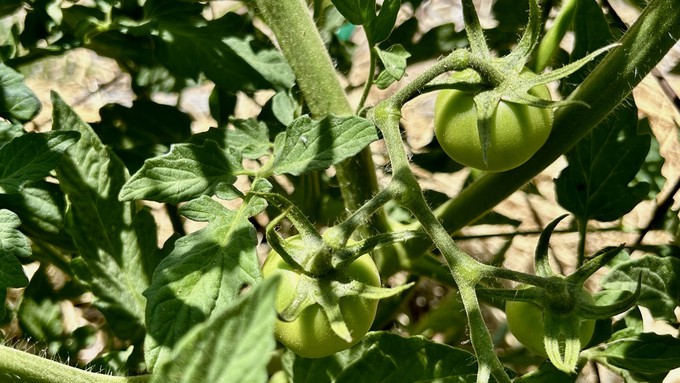
Rare August rain could arrive Friday; be ready for a 25-degree swing in high temperatures

The cooler weather this week should allow tomatoes to set new fruit, before a return of triple-digit temperatures. Kathy Morrison
Here’s something you don’t often hear in August in Sacramento: “Keep your umbrella handy.”
According to the National Weather Service, an unusual and strong weather system will blow into Northern California on Thursday night along with the possibility of thunderstorms. This cold front will drop temperatures as well as some precipitation.
As this “uncommon” weather system moves through, Sacramento has a 48% chance of rain on Friday afternoon and evening, says the weather service. The highest probability of rain is north of Interstate 80 including the possibility of cloud bursts and small hail.
Wet or not, Friday (Aug. 23) will seem downright chilly. Sacramento’s high temperature is forecast to be only 75 degrees – almost 20 degrees below normal for that date. Cloudy conditions will keep temperatures cool on Saturday (with an expected high of 81) before the heat returns.
And that warm-up will be fast; the expected high in Sacramento next Tuesday is 100 degrees.
Enjoy this cool streak while it lasts – and keep an eye on your tomatoes. If they had flowers bloom during recent cooler days, they’re likely setting fruit now. Fertilize them with some tomato food high in phosphate and potassium (the second and third macro-nutrient numbers on the fertilizer bag). That will help those baby tomatoes grow.
Also, deep water tomatoes before and after feeding. To help those vines hold onto their fruit, make sure their soil stays evenly moist during next week’s rapid warm-up.
Yo-yo temperatures can confuse flowering plants, especially roses. Blind shoots – stems with no terminal bud – are common on rose bushes after sudden temperature drops or increases. Blind shoots will never bloom; they just keep growing more leaflets. Snip them off (pruning about a half inch above a five-leaf leaflet) to prompt the bush to push out new shoots with buds.
While you’re at it, remove spent blooms on bushes, too. That removes a source of fungal disease as well as cues the bush to push out more flowers. Expect the new roses to open in six to eight weeks – just in time for fall bouquets.
For more on Sacramento weather: https://www.weather.gov/sto/.
Comments
0 comments have been posted.Sacramento Digs Gardening to your inbox.
Food in My Back Yard Series
May 6: Maintain soil moisture with mulch for garden success
April 29: What's (already) wrong with my tomato plants?
April 22: Should you stock up on fertilizer? (Yes!)
April 15: Grow culinary herbs in containers
April 8: When to plant summer vegetables
April 1: Don't be fooled by these garden myths
March 25: Fertilizer tips: How to 'feed' your vegetables for healthy growth
March 18: Time to give vegetable seedlings some more space
March 11: Ways to win the fight against weeds
March 4: Potatoes from the garden
Feb. 25: Plant a fruit tree now -- for later
Feb. 18: How to squeeze more food into less space
Feb. 11: When to plant? Consider staggering your transplants
Feb. 4: Starting in seed starting
Sites We Like
Garden Checklist for week of May 11
Make the most of the lower temperatures early in the week. We’ll be back in the 80s by Thursday.
* Plant, plant, plant! It’s prime planting season in the Sacramento area. Time to set out those tomato transplants along with peppers and eggplants. Pinch off any flowers on new transplants to make them concentrate on establishing roots instead of setting premature fruit.
* Direct-seed melons, cucumbers, summer squash, corn, radishes, pumpkins and annual herbs such as basil.
* Harvest cabbage, lettuce, peas and green onions.
* In the flower garden, direct-seed sunflowers, cosmos, salvia, zinnias, marigolds, celosia and asters. (You also can transplant seedlings for many of the same flowers.)
* Plant dahlia tubers.
* Transplant petunias, marigolds and perennial flowers such as astilbe, columbine, coneflowers, coreopsis, dahlias, rudbeckia and verbena.
* Keep an eye out for slugs, snails, earwigs and aphids that want to dine on tender new growth.
* Feed summer bloomers with a balanced fertilizer.
* For continued bloom, cut off spent flowers on roses as well as other flowering plants.
* Add mulch to the garden to maintain moisture. Mulch also cuts down on weeds. But don’t let it mound around the stems or trunks of trees or shrubs. Leave about a 6-inch-to-1-foot circle to avoid crown rot or other problems.
* Remember to weed! Pull those nasties before they set seed.
* Water early in the day and keep seedlings evenly moist.